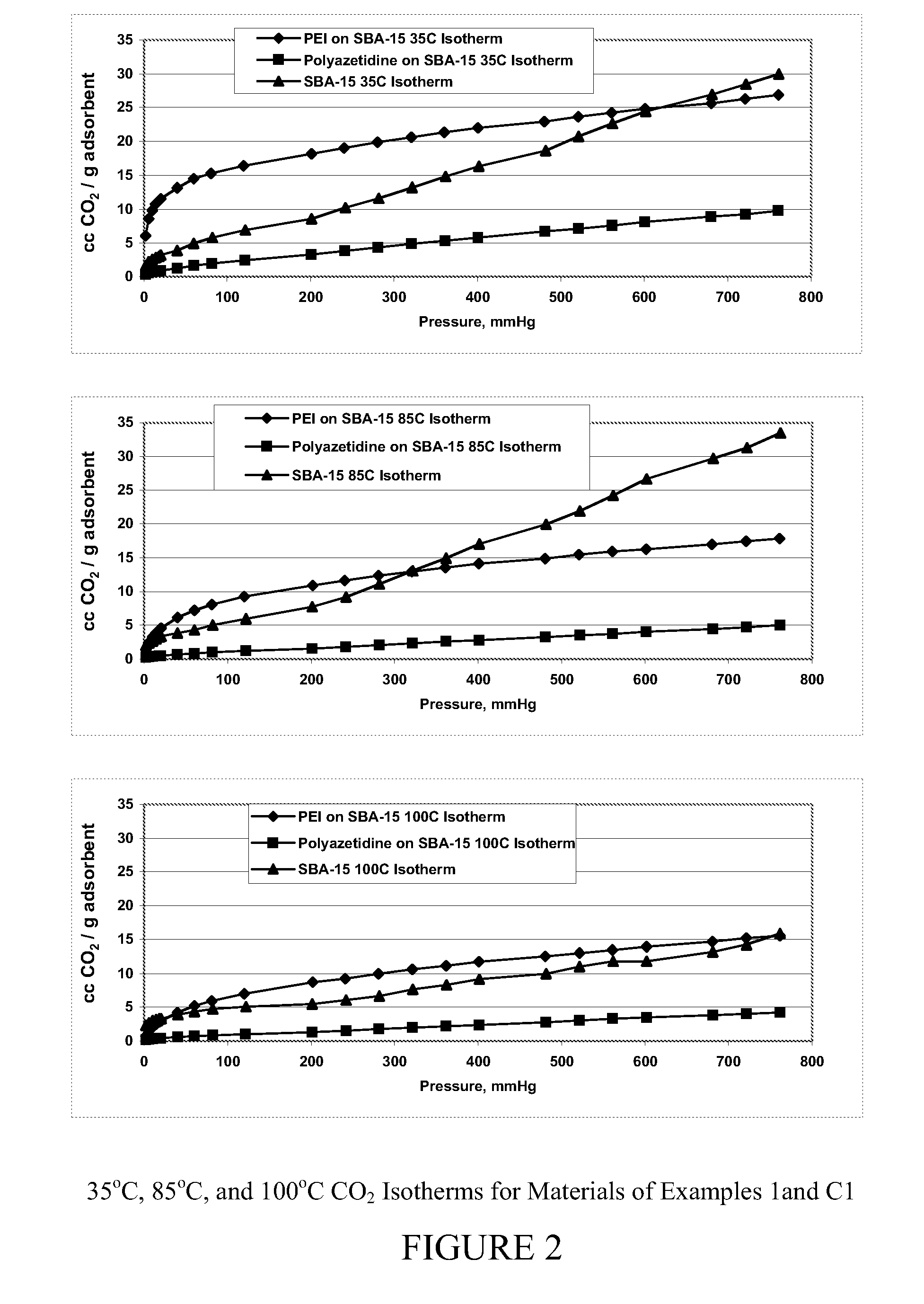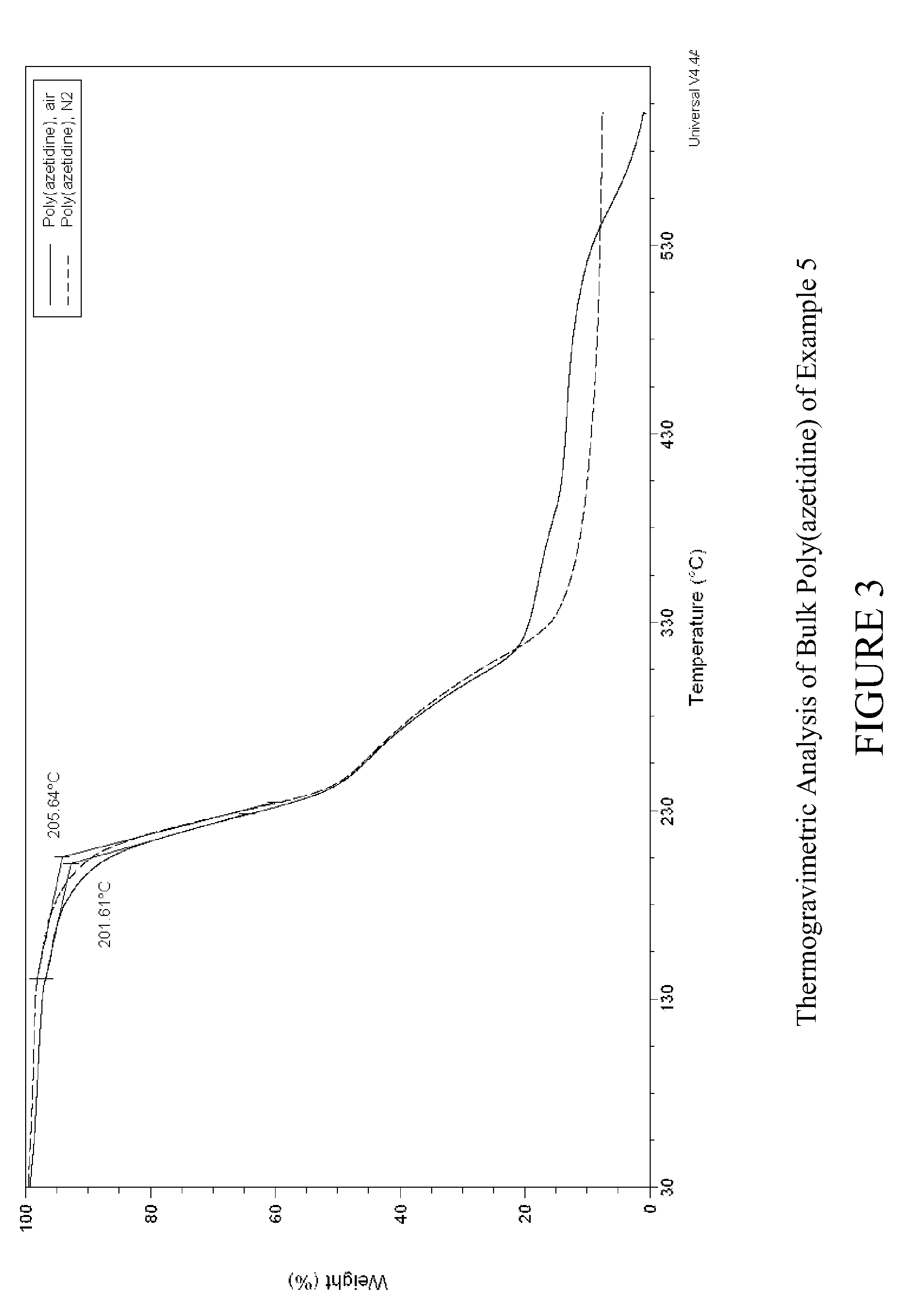Carbon dioxide sorbents
a technology of carbon dioxide and sorbent, which is applied in the direction of inorganic chemistry, hydrogen sulfides, chemical separation, etc., can solve the problems of unsatisfactory side, non-selective technique for securing the polymer molecules, and non-optimal surface area of chemical sorben
- Summary
- Abstract
- Description
- Claims
- Application Information
AI Technical Summary
Benefits of technology
Problems solved by technology
Method used
Image
Examples
example 1
Synthesis of SBA-15-Supported Poly(Azetidine) in Toluene at 25° C. Using Acetic Acid Initiator
[0046]SBA-15 mesoporous silica was prepared by mixing 100 mL of a 1.7 M aqueous HCl solution with 2.83 g Pluronic® P-123 organic template. To this solution was added slowly at room temperature a 6.0 g (6.4 mL) portion of tetraethylorthosilicate. The resulting mixture was stirred for 30 minutes, heated to 40° C. for 20 hours, and aged at 90° C. without stirring for 1 day. It was cooled and the solids were collected by filtration, rinsed with deionized water and acetone, and dried at 90° C. under vacuum. A 2.0 g portion of the resultant material was dispersed in 240 mL of a 48 wt % aqueous H2SO4 solution, heated at 95° C. for 1 day, and cooled to room temperature. The solids were again collected by filtration rinsed with deionized water until the filtrate showed a pH of 7. The product SBA-15 solids were then dried at 95° C. under vacuum (BET surface area 622 m2 / g; pore volume 1.21 cc / g; struc...
example 2
Synthesis of Oligomeric Bulk Poly(Azetidine) in Toluene at 80° C. Using Acetic Acid Initiator
[0050]Azetidine (1.035 g, 18.1 mmol; distilled as described in Example 1 hereof and stored in a freezer in the drybox between uses) was mixed with 5 mL dry toluene in a Schlenk tube in the dry-box along with a stirbar. A stirbar was added and the tube was removed from the drybox and placed under argon on a Schlenk line. Glacial acetic acid (100 mg, 1.67 mmol, was prepared and transferred as described in Example 1 hereof) was added. The Schlenk tube was partially immersed in an 80° C. oil bath (up to the level of liquid inside) leaving a large volume of empty tube above. Tubing containing a flow of chilled water was wrapped around this empty volume of Schlenk tune a few times to create a condensing zone. After the contents of the tube had warmed to 80° C., the tube was shut off from argon and stirred for 1 hour. Subsequently, the tube was opened to the atmosphere, cooled, and the contents wer...
example 3
Synthesis of Oligomeric Bulk Poly(Azetidine) in Toluene at 100° C. Using Acetic Acid Initiator
[0051]A procedure similar to Example 2 hereof was performed using 1.3 g (22.8 mmol) azetidine, 103 mg (1.72 mmol) acetic acid, and 5 mL dry toluene. The polymerization was carried out for 20 hours at 100° C. in a sealed Schlenk tube wrapped with chilled-water tubing. After cooling, the contents of the tube were not diluted with additional toluene; the polymer solution was transferred to a vial and the toluene was evaporated by blowing nitrogen into the vial, followed by drying the polymer residue under high vacuum at room temperature. A ˜150 mg portion (12%) of light yellow, viscous liquid was obtained. The 1H and 13C NMR spectra of this product were more complex than the sample made at 80° C., but still suggested the predominant species had an intact cyclic azetidine endgroup (indicating low molecular weight). 1H NMR (CDCl3, 400 MHz): major peaks at δ 3.07 (tr, >4H, J=7.1 Hz, ring NCH2—), ...
PUM
| Property | Measurement | Unit |
|---|---|---|
| temperature | aaaaa | aaaaa |
| temperature | aaaaa | aaaaa |
| temperatures | aaaaa | aaaaa |
Abstract
Description
Claims
Application Information
 Login to View More
Login to View More - R&D
- Intellectual Property
- Life Sciences
- Materials
- Tech Scout
- Unparalleled Data Quality
- Higher Quality Content
- 60% Fewer Hallucinations
Browse by: Latest US Patents, China's latest patents, Technical Efficacy Thesaurus, Application Domain, Technology Topic, Popular Technical Reports.
© 2025 PatSnap. All rights reserved.Legal|Privacy policy|Modern Slavery Act Transparency Statement|Sitemap|About US| Contact US: help@patsnap.com



